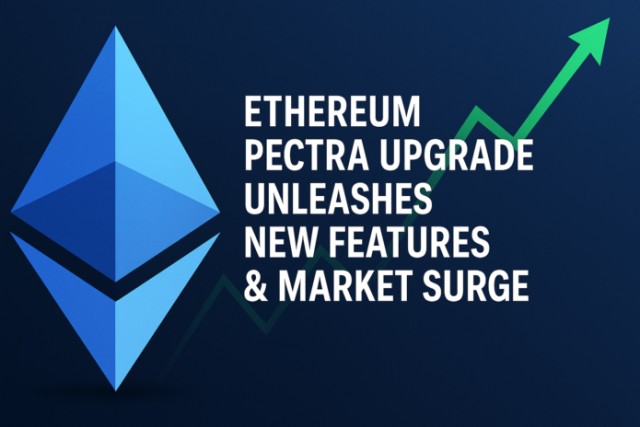Ethereum—the world’s leading smart contract platform—has been on a steady journey of transformation. In 2025, two major upgrades, Dencun and Pectra, have fundamentally reshaped the Ethereum network. Whether you’re a long-term investor, a DeFi user, or just curious about the future of Web3, understanding these changes is crucial.
In this article, we’ll break down the details of these upgrades, why they matter, and how they affect you as a crypto investor.
The Evolution of Ethereum: From Merge to Modular Scaling
Ethereum’s development has always been focused on three core goals:
Scalability: Handling more transactions at lower cost.
Security: Keeping the network safe and robust.
Sustainability: Transitioning to energy-efficient operations.
After transitioning from proof-of-work (PoW) to proof-of-stake (PoS) in The Merge (September 2022), Ethereum has continued to evolve through layered upgrades. The 2024 Dencun upgrade and the 2025 Pectra upgrade are the latest milestones toward achieving Ethereum’s long-term vision.
Dencun Upgrade (Activated March 13, 2024): Bringing Proto-Danksharding to Life
Dencun is a combination of two core upgrades: Cancun (execution layer) and Deneb (consensus layer). But the real game-changer in this upgrade is the introduction of proto-danksharding via EIP-4844.
What is Proto-Danksharding?
Danksharding is Ethereum’s future data sharding architecture designed to massively increase the amount of data available to rollups. Proto-danksharding (a precursor to full danksharding) introduces a new transaction type that includes “blobs”—temporary, inexpensive, off-chain data chunks.
Key Benefits:
Lower Fees for Layer-2 Rollups:
Blobs allow rollups like Arbitrum, Optimism, and Base to post transaction data more cheaply, which can cut fees by over 90%. This is huge for the average DeFi user who’s tired of high gas fees.
Increased Network Efficiency:
Blobs expire after ~2 weeks, reducing permanent blockchain bloat and keeping Ethereum nodes lean and efficient.
Better User Experience:
With lower Layer-2 fees and more scalability, users experience faster and cheaper transactions, which encourages more dApp usage.
Why It Matters:
Dencun was a major step toward Ethereum’s modular future. By making Layer-2 chains more efficient and affordable, it pushes Ethereum closer to mass adoption while avoiding centralization risks.
Pectra Upgrade (Activated May 7, 2025): Supercharging Ethereum Staking and Wallets
Just months after Dencun, Ethereum launched Pectra—its most extensive update since The Merge. Pectra incorporates 11 Ethereum Improvement Proposals (EIPs) and targets both backend and frontend improvements.
Key Changes Introduced in Pectra:
Raised Maximum Stake per Validator: From 32 ETH to 2,048 ETH
Previously, large stakers had to manage thousands of 32 ETH validator nodes. This change reduces complexity and operational costs for institutional validators and large staking pools, while still maintaining decentralization.
Smart Accounts (ERC-4337 Integration)
Also known as “account abstraction,” this allows users to interact with Ethereum using smart wallets rather than externally owned accounts (EOAs). Benefits include:
Social recovery (no seed phrase required)
Gasless transactions (pay fees in any token)
Automated recurring payments
Simplified onboarding for non-technical users
Delegated Staking
Pectra enables native delegation, allowing users to stake ETH by delegating to validators without running nodes or using third-party staking platforms. This promotes more decentralized participation.
Better Layer-2 Compatibility
Pectra improves communication and data processing between Ethereum and Layer-2 networks, setting the stage for improved rollup integrations and multi-chain applications.
Developer-Focused Upgrades
Improvements to EVM execution, transaction batching, and signature verification make smart contract development faster, cheaper, and safer.
Why Pectra is a Big Deal:
While Dencun improved the data layer, Pectra upgrades Ethereum’s user and developer experience. It helps Ethereum bridge the gap between Web3’s complexity and Web2-style usability.
Market Impact: What Has Changed?
Interestingly, Ethereum’s price has not surged in direct response to these upgrades—ETH was trading around $1,822 in early May 2025, only slightly up since the Pectra launch. However, this doesn’t reflect the fundamental strength these upgrades have added.
Institutional confidence is growing, Layer-2 activity is expanding, and developer momentum is increasing. Think of these upgrades as building the foundation for Ethereum’s next bull cycle.
What It Means for You as an Investor or User
Here’s how you might be affected by Ethereum’s recent upgrades:
✔Lower Transaction Fees:
Expect significantly cheaper interactions on Layer-2 networks like Arbitrum, Optimism, and Base.
✔ Enhanced Wallet Functionality:
New smart accounts mean safer, more convenient wallet experiences with features like social recovery and gasless transactions.
✔ More Opportunities for Passive Income:
With delegated staking, earning staking rewards becomes easier and more secure—even for non-tech-savvy users.
✔Improved Network Performance:
Expect faster finality, more efficient rollups, and fewer failed transactions on both Layer-1 and Layer-2 platforms.
✔Stronger Ecosystem Growth:
These upgrades improve the entire Ethereum economy—from NFTs and DAOs to DeFi and gaming—paving the way for broader Web3 adoption.
Looking Ahead: What’s Next for Ethereum?
The next major milestones include:
Full Danksharding implementation
Verkle Trees (to reduce proof sizes and node storage needs)
Continued progress on the “Surge,” “Scourge,” and “Purge” phases of Ethereum’s roadmap
Ethereum is building toward being the world’s most scalable and user-friendly decentralized computer.
Ethereum’s Dencun and Pectra upgrades in 2024–2025 represent a pivotal leap forward. They don’t just improve technical efficiency—they open the door to more inclusive, secure, and scalable applications across finance, art, governance, and more.
While price movements have remained modest, the technological foundation laid by these upgrades is likely to support explosive innovation—and eventually, value growth—in the years ahead.
























